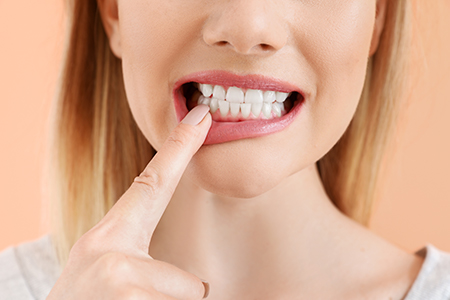Gum disease affects a large portion of adults and is a primary reason people lose teeth as they age. At Wonderful Smiles Dental, our focus is on spotting problems early, tailoring treatment to each patient’s needs, and keeping periodontal health stable over time so you can enjoy a comfortable, functional smile for years to come.
Gums do more than frame your teeth; they are living tissue that protects the roots and supports the bone beneath. When gum tissue is healthy, it forms a tight seal against the tooth surface and helps distribute the forces of chewing. Damage to this protective system compromises stability and makes routine care more difficult, which can accelerate wear and tooth loss.
Many people think bleeding or sensitivity is a minor nuisance, but these symptoms are early warnings that the gum environment is out of balance. Addressing those signs promptly preserves tissue health and reduces the chance that a small problem becomes a complicated one. Prevention and vigilance often spare patients more invasive procedures later on.
Our team views periodontal health as an essential part of dental care, not an optional extra. By combining careful clinical exams with clear patient education, we help people understand what their gums are telling them and how to respond with practical habits and professional support.
Periodontal disease begins when bacterial plaque accumulates at the gumline and below it. If plaque is left in place, minerals in saliva cause it to harden into tartar, which clings tightly to tooth surfaces and shelters bacteria from ordinary brushing. The immune system reacts to this persistent bacterial presence, producing inflammation that can damage both soft tissue and the bone that anchors teeth.
As inflammation continues, the junction between gum and tooth can break down and deepened spaces—called periodontal pockets—can form. These pockets create protected environments where bacteria flourish and are more difficult to remove without professional intervention. Over time, untreated pockets can lead to measurable bone loss and increased tooth mobility.
Because individual susceptibility varies, two people with similar hygiene routines may experience very different outcomes. Regular dental assessments, periodontal probing, and radiographs when indicated allow clinicians to map disease activity and intervene before destruction becomes extensive.
Signs you should have a periodontal exam include:
Gums that are red, swollen, or tender to the touch
Bleeding during brushing or flossing
Gums that seem to pull away from the teeth or expose roots
Ongoing bad breath or a persistent bad taste
Teeth that feel loose or a shifting bite

Recent research shows a clear link between long-term oral inflammation and broader health concerns. Chronic periodontal inflammation can influence blood vessel function, complicate diabetes management, and play a role in respiratory health. While gum disease is not the direct cause of these conditions, it can be a contributing factor that makes general health harder to manage.
This connection is why periodontal care benefits from a comprehensive view of health. We consider medications, systemic conditions, and lifestyle factors such as tobacco use and nutrition when designing treatment. That holistic perspective helps ensure dental care supports a patient’s overall wellness goals.
Patients who prioritize gum health often experience practical improvements beyond the mouth: easier chewing, fewer sore spots, and greater confidence in daily oral care. Coordinated care between dental and medical providers can also improve outcomes for people with chronic health issues.
Gingivitis is the earliest stage of periodontal disease and, importantly, it is usually reversible. At this stage the problem is limited to inflammation of the gum tissue without loss of bone. Typical signs include redness, swelling, and minor bleeding—signals that the area needs better cleaning and professional attention.
Treatment for gingivitis centers on removing the bacterial irritants and reestablishing healthy oral hygiene habits. A professional hygiene appointment removes plaque and calculus, while targeted instruction on brushing technique and interdental cleaning helps patients maintain those gains at home. Short-term monitoring ensures the tissues are returning to health.
Consistency is the key to lasting success. With routine professional care and a thoughtful home regimen, most cases of gingivitis resolve completely and the risk of progression to deeper disease is substantially reduced.

Once periodontal infection reaches the bone and connective tissues, the condition is called periodontitis. This stage presents with deeper pocketing, gum recession, and detectable bone loss on x-rays. The treatment goal shifts from simple reversal to stabilization: stopping ongoing destruction and restoring a healthier environment for maintenance.
Therapies are staged to match disease severity. Initial non-surgical care may include deeper cleaning beneath the gumline and adjunctive antimicrobial strategies when appropriate. When pockets remain deep or anatomy is unfavorable for cleaning, surgical approaches can improve access, reshape tissues, and in some cases support regeneration of lost structures.
Recovery depends on careful follow-up. A personalized maintenance schedule, ongoing reinforcement of home care, and periodic reassessment are essential to keep inflammation controlled and to protect the long-term function of treated teeth.

When disease is caught early or when damage is limited, non-surgical approaches are often an effective first step. Scaling and root planing remove bacterial deposits from below the gumline and smooth root surfaces to discourage new buildup. These procedures, combined with improved daily home care, frequently reduce inflammation and pocket depth.
In selected cases, clinicians may recommend localized antimicrobial treatments to help control persistent bacteria. The decision to add adjunctive therapy is based on how the tissues respond to initial care and on clinical measures of disease activity.
After non-surgical treatment, regular periodontal maintenance visits are essential. These follow-up appointments let clinicians confirm healing, remove any recurrent deposits, and support patients in keeping their home-care routine effective.
When pockets are too deep for effective cleaning or when bone loss is significant, surgical procedures provide better access to infected areas and allow the clinician to recontour tissues for healthier long-term anatomy. Flap procedures expose root surfaces for thorough debridement and permit reshaping of bone where necessary.
Regenerative techniques — such as bone grafting and guided tissue regeneration — may be employed to rebuild lost support around teeth in suitable cases. These treatments aim to restore the underlying structure and improve the prognosis for affected teeth.
Modern tools, including selective use of lasers in specific situations, can complement conventional surgery. Treatment choices are individualized, weighing the expected benefits against the patient’s overall health and treatment priorities.
Healthy gums require a partnership between a knowledgeable clinical team and an informed, committed patient. If you’ve noticed bleeding, swelling, or changes in how your teeth feel, don’t wait for symptoms to get worse. Contact Wonderful Smiles Dental to learn more about periodontal care options and how we can help you protect your smile and overall wellbeing.
Most people don’t realize that periodontal disease is the leading cause of tooth loss among adults. According to statistics from the Centers for Disease Control and Prevention, one out of every two adults over the age of 30 in the United States has periodontal disease.
You may be surprised to learn that the human mouth is home to a wide variety of microbes. The fact is that over 700 different strains of bacteria have been detected in the oral cavity. Although some of these bacteria are beneficial, others are harmful to oral health. Without proper oral hygiene and routine dental care, these harmful bacteria can cause tooth decay and gum disease, compromising both your oral health and overall wellbeing.
In addition to inadequate oral hygiene and infrequent professional care, other factors, including smoking, genetic tendencies, and unchecked diabetes, can contribute to the escalation of periodontal disease.
Your gums and teeth have an interdependent relationship, which means healthy teeth depend on the support of healthy gums. Also, taking care of your smile does more than keep your teeth and gums in optimal condition; good oral health also supports systemic health. In addition to being the leading cause of tooth loss in adults, researchers are finding more and more links between periodontal disease and a number of medical problems, including heart disease, stroke, diabetes, respiratory problems, and adverse pregnancy outcomes such as pre-term and low birth-weight babies.
If you notice that your gums are bleeding with the slightest pressure while brushing or flossing, it’s a sign of gingivitis. Although gingivitis is the earliest stage of gum disease, it can easily be reversed with deeper cleanings as well as an improved regimen of oral hygiene at home.
In the absence of professional treatment and better home care, gingivitis progresses to the next stage, which is known as periodontitis. In this stage, the connective tissue and bone that hold the teeth in place begin to break down with an increase in pocketing between the teeth and bone, gum recession, and bone loss. Without proper treatment by your dentist, periodontitis will progress from a mild to moderate loss of supporting tissue to the destruction of the bone around the teeth.
Although gingivitis can often be reversed with improved oral hygiene and professional cleanings, as periodontal disease advances, more extensive procedures are required to halt its progression. Based on a complete assessment of your periodontal health and a review of possible contributing factors, our office will recommend the best options in care. Treatment for periodontitis may include a series of deeper cleanings known as root planing and scaling, surgical procedures to reduce pocket depth, bone or tissue grafts, laser procedures, or antimicrobial medications.
The cost of care depends on the type of procedures required to restore your periodontal health. If you have dental insurance, plans often cover treatment to prevent gum disease as well as many procedures to treat the various stages of gum disease. Our goal is to help patients restore and maintain good oral health. We do all we can to help you begin care without additional stress or delay. Our business office works with you to maximize your benefits and provide easier, more convenient payment options.
By seeing our office regularly for care and doing your best to eat a healthy diet and practice good oral hygiene, you can keep your smile in tip-top shape as well as protect your overall wellbeing.
At the office of Wonderful Smiles Dental, we provide a comprehensive range of services to address all your oral healthcare needs. You can rest assured that your smile is in the best of hands at our office. Our skilled and experienced team maintains a position at the forefront of advances in care and remains dedicated to providing the highest quality of skilled and compassionate treatment.
Periodontal disease, often called gum disease, refers to inflammatory conditions that affect the periodontium — the tissues that surround and support the teeth. It begins when bacterial plaque and calculus accumulate along the gumline and below it, triggering an immune response. Left unchecked, this inflammation can damage soft tissue and the underlying bone that holds teeth in place.
Because early stages can be painless, many patients do not realize a problem is developing until tissue loss occurs. Diagnosis is based on a clinical exam and measurements of pocket depth, bleeding, recession and radiographic assessment when indicated. At the office of Wonderful Smiles Dental we focus on early detection and individualized treatment plans to preserve oral health.
Periodontal disease is caused primarily by bacteria in dental plaque that accumulate on tooth surfaces and below the gumline. Contributing factors include inadequate oral hygiene, smoking, certain medications, genetic susceptibility and medical conditions such as diabetes that affect the body's inflammatory response. Over time, bacterial toxins and the body's immune reaction lead to breakdown of connective tissue and bone.
Local factors such as calculus, poorly fitting restorations and crowded teeth can accelerate disease progression by making plaque harder to remove. Lifestyle habits and systemic health influence severity and treatment response, so a thorough health and dental history is essential during evaluation. Regular professional care and effective home hygiene help control bacterial accumulation and lower risk.
Early signs of gum disease include red, swollen or tender gums and bleeding during brushing or flossing. Patients may also notice persistent bad breath, a bad taste in the mouth, or increased tooth sensitivity. These symptoms often precede more serious changes and should prompt an examination.
As disease advances, gums can recede, pockets can form between teeth and bone, and teeth may feel loose or shift position. Discharge from gums, changes in bite or the fit of partial dentures, and discomfort when chewing are additional warning signs. Timely evaluation can often limit damage and improve treatment outcomes.
Gingivitis is the initial, reversible stage of gum disease characterized by inflammation confined to the gum tissue without loss of supporting bone. It typically presents with redness, swelling and bleeding but the periodontal attachment remains intact. With appropriate oral hygiene and professional cleaning, gingivitis can usually be completely reversed.
Periodontitis occurs when inflammation extends deeper, causing destruction of the connective tissue and alveolar bone that support the teeth. This stage features increased pocket depths, tissue recession and possible tooth mobility and requires more advanced intervention to halt progression. Treatment for periodontitis may include scaling and root planing, adjunctive antimicrobial therapy and, in some cases, surgical procedures.
Diagnosis begins with a comprehensive clinical exam that includes measuring pocket depths around each tooth, checking for bleeding on probing, and assessing gingival recession and tooth mobility. The dental team also reviews medical and dental history to identify risk factors that affect disease development and healing. Radiographs are used when needed to evaluate bone levels and detect patterns of bone loss.
Together, these findings determine disease severity and guide the treatment plan and maintenance schedule. Periodontal charting at regular intervals allows providers to monitor response to therapy and catch any recurrence early. Clear communication with the patient about findings and home care recommendations is an important part of the diagnostic process.
Non-surgical care focuses on removing plaque and calculus below the gumline and reducing bacterial load to allow healing of the periodontal tissues. Scaling and root planing is the primary conservative procedure, in which deposits are removed and root surfaces smoothed to help reattach gum tissue. Antimicrobial agents may be applied locally under the gumline or prescribed systemically as adjuncts when indicated.
Improved daily oral hygiene, smoking cessation and management of systemic conditions like diabetes are essential complements to professional therapy. Regular maintenance visits for periodontal cleaning and monitoring help sustain treatment gains. If non-surgical measures do not achieve sufficient pocket reduction, surgical options may be discussed.
Surgery is typically considered when pocket depths exceed the reach of non-surgical therapy, commonly around 5 millimeters or more, or when anatomical factors impede cleaning and healing. The goal of periodontal surgery is to remove bacteria and diseased tissue, reduce pocket depth, recontour bone when necessary and create conditions that allow the patient to maintain oral hygiene. Procedures vary from flap surgery to osseous recontouring depending on each case.
Many surgical procedures are performed under local anesthesia and may involve sutures and a period of postoperative care to control discomfort and support healing. Laser-assisted techniques can be used for select procedures to reduce tissue trauma and enhance precision when appropriate. Your dental provider will explain the recommended approach, expected healing timeline and home care instructions before any surgical treatment.
Regenerative procedures aim to rebuild lost bone and connective tissue where periodontal disease has created defects, improving both function and stability of teeth. Techniques include bone grafting, guided tissue regeneration with barrier membranes and the use of biologic agents that promote new tissue growth. These approaches are selected based on the size and location of the defect and the patient's overall health.
Bone grafts provide a scaffold for new bone formation while membranes help direct healing toward regeneration rather than repair by scar tissue. When successful, regeneration can reduce pocket depth, support teeth and create a more favorable environment for oral hygiene and potential restorative procedures. Careful case selection and adherence to postoperative instructions are important for predictable outcomes.
Maintenance combines meticulous daily oral hygiene with regular professional care tailored to the patient's risk level and treatment history. Effective home care includes brushing twice daily with a fluoride toothpaste, cleaning between teeth daily with floss or interdental brushes, and using adjuncts like antimicrobial rinses when recommended. Lifestyle choices such as quitting tobacco and managing systemic health conditions also support long-term periodontal stability.
Following active therapy, patients typically enter a periodontal maintenance program with visits every three months or at intervals recommended by the clinician to monitor healing and remove renewing deposits. These visits include assessment of pocket depth, reinforcement of home care and professional cleaning to prevent recurrence. Wonderful Smiles Dental works with patients to develop individualized maintenance plans that focus on preserving results and preventing future disease.
Research has shown associations between periodontal disease and systemic conditions such as diabetes, cardiovascular disease and respiratory problems, with inflammation being a common link. While associations do not imply that gum disease directly causes these conditions, systemic health can influence periodontal disease severity and the body's ability to heal. For example, poorly controlled diabetes can increase susceptibility to infections and impair periodontal treatment outcomes.
Because of these links, dental providers consider a patient's overall health when planning periodontal therapy and may coordinate care with the patient's medical team when necessary. Identifying and managing risk factors, optimizing systemic health and communicating medical history help improve treatment predictability. Regular periodontal care is an important part of maintaining both oral and general health.
